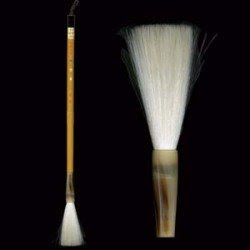
Written as sheep wool, it’s read羊毛 (you-mou).
Although it’s the most common brush, a difference in the ratio of the tip length to the bundle diameter makes the brush difficult and hard to write with.
A brush with a small diameter and a long tip is called長峰 (chou-hou) and a brush with an extremely long tip is called超長峰 (chou-chou-hou), meaning that it’s beyond the length of chou-hou.
“超” means “beyond” and “長” means “length”. (It’s easy to understand in kanji.)
It’s hard to explain because both “長” and “超” is pronounced “chou”.
This chou-hou, which is the most difficult one, is my favorite.
It is 1cm in diameter and 12cm long in the tip – it doesn’t listen to me like an untamed horse.


No comments:
Post a Comment